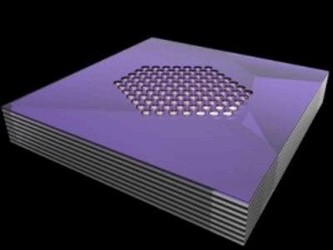Photonic Hypercrystals Combine Best Features Of Metamaterials And Photonic Crystals
By Jof Enriquez,
Follow me on Twitter @jofenriq

Scientists at The City College of New York (CCNY) and Purdue University have demonstrated a new type of composite artificial media, called photonic hypercrystals, which combine the best characteristics of metamaterials and photonic crystals — two promising technologies in the field of optoelectronics that depend on frequency resonance mechanisms that limit bandwidth, or suffer from poor light-coupling mechanisms.
Photonic hypercrystals overcome these limitations by combining the large broadband photonic density of states provided by hyperbolic metamaterials with the light-scattering efficiency of photonic crystals.
"In particular, surface waves supported by a hypercrystal possess the properties of both the optical Tamm states in photonic crystals and surface-plasmon polaritons at the metal-dielectric interface," explained Evgenii E. Narimanov, professor of electrical and computer engineering at Purdue University, who first described photonic hypercrystals in a paper in APS Physical Review X (PRX).
Narimanov collaborated with Vinod M. Menon, professor of physics in CCNY’s Division of Science, and CCNY graduate students Tal Galfsky and Jie Gu in testing the effectivity and efficiency of photonic hypercrystals to manipulate light-matter interaction, which are essential in natural phenomena like photosynthesis, and in technologies like lasers and solar cells.
In the research group's paper published in a recent issue of Proceedings of the National Academy of Sciences of the United States of America (PNAS), they report achieving simultaneous enhancement of spontaneous emission rate (20×) and light outcoupling (100×) from quantum dots embedded in the hypercrystal. The scientists attribute these promising results to the unique combination of length scales in the features of the hypercrystal, as well as the inherent properties of the nanoscale structures.
"Such designer photonic media with complete control over the optical properties provide a platform for broadband control of light–matter interaction," wrote the researchers.
More specifically, photonic hypercrystals can pave the way for ultrafast LEDs for Li-Fi (uses visible light to transmit data electromagnetically), enhanced absorption in solar cells, and the development of single photon emitters for quantum information processing, said Menon in a press release.
This latest research in optoelectronics was supported by the Army Research Office, the National Science Foundation – Division of Materials Research MRSEC (Materials Research Science and Engineering Centers) program, and the Gordon and Betty Moore Foundation.
